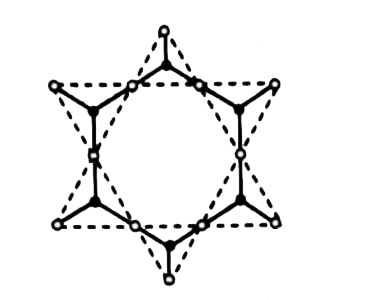Which will have the maximum value of electron affinity Ox,Oy,Oz [x,y and z respectively are 0,−1 and −2]?
Ox
Oy
Oz
All have equal.
To determine which of the species Ox,Oy,Oz (where x=0,y=−1,z=−2) has the maximum value of electron affinity, we need to analyze each species:
1. Identify the species:
- O0 is the neutral oxygen atom (O).
- O−1 is the negatively charged ion (O⁻).
- O−2 is the doubly negatively charged ion (O²⁻).
2. Understand electron affinity:
- Electron affinity is the energy change that occurs when an electron is added to a neutral atom or ion. A higher (more positive) electron affinity means that the species can more readily accept an electron.
3. Evaluate O0 (Neutral Oxygen):
- As a neutral atom, O0 can easily accept an electron without any repulsion from existing negative charges. This means it has a relatively high electron affinity.
4. Evaluate O−1 (O⁻):
- The O⁻ ion already has a negative charge. When another electron is added, there will be repulsion between the incoming electron and the existing negative charge. This repulsion makes it less favorable for O⁻ to gain another electron compared to neutral oxygen.
5. Evaluate O−2 (O²⁻):
- The O²⁻ ion has two negative charges. The repulsion between the incoming electron and the two existing negative charges is even greater than in the case of O⁻. Therefore, O²⁻ is the least favorable for gaining an additional electron.
6. Conclusion:
- Since O0 (neutral oxygen) experiences no repulsion and can easily accept an electron, it will have the highest electron affinity. In contrast, O−1 and O−2 will have lower electron affinities due to the repulsion from their existing negative charges.
Thus, the species with the maximum value of electron affinity is O0.
Final Answer:
The maximum value of electron affinity is for O0 (neutral oxygen).
- O0 is the neutral oxygen atom (O).
- O−1 is the negatively charged ion (O⁻).
- O−2 is the doubly negatively charged ion (O²⁻).
- Electron affinity is the energy change that occurs when an electron is added to a neutral atom or ion. A higher (more positive) electron affinity means that the species can more readily accept an electron.
- As a neutral atom, O0 can easily accept an electron without any repulsion from existing negative charges. This means it has a relatively high electron affinity.
- The O⁻ ion already has a negative charge. When another electron is added, there will be repulsion between the incoming electron and the existing negative charge. This repulsion makes it less favorable for O⁻ to gain another electron compared to neutral oxygen.
- The O²⁻ ion has two negative charges. The repulsion between the incoming electron and the two existing negative charges is even greater than in the case of O⁻. Therefore, O²⁻ is the least favorable for gaining an additional electron.
- Since O0 (neutral oxygen) experiences no repulsion and can easily accept an electron, it will have the highest electron affinity. In contrast, O−1 and O−2 will have lower electron affinities due to the repulsion from their existing negative charges.
The maximum value of electron affinity is for O0 (neutral oxygen).
Topper's Solved these Questions
- PERIODIC TABLE & PERIODICITYBOOK - RESONANCE ENGLISHCHAPTER - PERIODIC TABLE & PERIODICITYEXERCISE - MISCELLANEOUS SOLVED PROBLEMS
7 Videos
- PERIODIC TABLE & PERIODICITYBOOK - RESONANCE ENGLISHCHAPTER - PERIODIC TABLE & PERIODICITYEXERCISE - Board Level Exercise
31 Videos
- PERIODIC TABLE & PERIODICITYBOOK - RESONANCE ENGLISHCHAPTER - PERIODIC TABLE & PERIODICITYEXERCISE - Advanced Level Problems
105 Videos
- P-BLOCK ELEMENTS (HALOGEN & NOBLE GASES)BOOK - RESONANCE ENGLISHCHAPTER - P-BLOCK ELEMENTS (HALOGEN & NOBLE GASES)EXERCISE - APSP PART-3
22 Videos
- QUALITATIVE ANALYSISBOOK - RESONANCE ENGLISHCHAPTER - QUALITATIVE ANALYSISEXERCISE - INORGANIC CHMISTRY(Qualitative analysis)
35 Videos
Similar Questions
The electron affinity values(inKJmole−1) of three halogens x, y and z are respectively −349,−333and−325. Then x, y and z respectively are
View SolutionFind the value of the determinant∣∣ ∣ ∣∣1xy+z1yz+x1zx+y∣∣ ∣ ∣∣
View SolutionThe electron affinity values (in kJmol−1 ) of three halogens, X, Y
and Z are respectively -349, -333 and -325. Then X, Y and Z are respectively
View SolutionCalculate vlaue of |x+y−z| for the followng sillicate [SixOy+z]z− anion.

View SolutionIf xyz=1 and x,y,z>0 then the minimum value of the expression (x+2y)(y+2z)(z+2x) is
View SolutionIf x,y and z are electronegativity, ionisation potential and electron−affinity respectively. Then the electron affinity (z) in the terms of electronegativity (x) and ionisation potential (y) will be :
View SolutionIf x2+y2+z2=1for x,y,z∈R, then the maximum value of x3+y3+z3−3xyz is
View SolutionThe ionic equivalent conductivities of C2O2−4,K⊕, and Na⊕ ions are x,y, and zScm2Eq−1 respectively. Calculate ∧∘eq of (NaOOC−COOK).
View SolutionIf a line makes angles 90o,135o,45owith the x, y and z-axes respectively, find its direction cosines.
View SolutionIf a line makes angles 90o,135o,45o with the x, y and z-axes respectively, find its direction cosines.
View Solution
